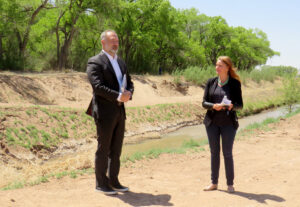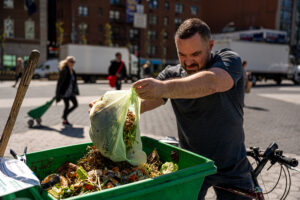Counselors stretched at Chicago’s majority Latino schools

The district plans to spend $5 million on 64 additional counselors by 2023.
Over the last year, Cameron Elementary school counselor John Casey consoled students who lost parents to COVID-19. He comforted youngsters grieving the death of 7-year-old Jaslyn Adams, a Cameron first-grader shot at a McDonald’s drive-through. He helped students navigate high school applications and academic troubles.
Often, he had to offer that support over a screen, to students with their cameras off or in bustling households with little privacy. One child went to the bathroom and locked the door so they could talk.
It was all part of an unprecedented school year that tested Chicago’s counselors like never before — and trained a stark spotlight on their caseloads.
In a state with one of the country’s worst counselor-to-student ratios, Chicago does better than many other Illinois districts, where two or more schools sometimes share a counselor: It staffs a counselor on every campus and spells out their roles. But caseloads exceed recommended standards at many Chicago schools — and are larger the more Latino students a campus serves, a Chalkbeat analysis found.
Elementary schools where 80% or more of the students are Latino — many of them in Chicago’s zip codes hardest hit by the pandemic — have an average counselor caseload of 665 students, with a few as high as 1,000 students or more.
Such ratios can leave counselors scrambling to provide emotional support, reach out to families who have disengaged from learning, and help students apply to high school. That workload is likely to grow as students grappling with trauma, anxiety, and learning gaps return to fully reopened campuses in the fall.
The district has said it will address those challenges by hiring 64 additional counselors over the next two years as part of a broader, federally funded pandemic recovery plan. The teachers union put money for an additional counselor at every school on its list of fall reopening demands.
A push to expand the ranks of school counselors is also underway statewide and across the country. With input from a state counselor group, Illinois recently released school reopening guidelines for fall that recommend 250-to-1 counselor ratios, the standard long embraced by the American School Counselor Association. The state’s average ratio is 626-to-1, the fourth highest nationally.
“This is a unique opportunity to develop our support services, but a challenging one as well,” said Vince Walsh-Rock, the executive director of the Illinois School Counselor Association. “We have to get it right. So many students’ lives are at stake.”
Jill Cook, executive director of the American School Counselor Association, says many counselors have shifted more of their time toward addressing students’ social and emotional needs — a trend likely to hold in the fall.
High ratios at majority Latino school
Over the past five years, Chicago has increased its counselor ranks by 5%, to about 730 professionals across about 500 district-run schools, even as its student enrollment has continued to decline. On average, elementary school counselors serve about 500 students, while their high school colleagues work with roughly 250 students, the national counselor group’s recommendation.
The district, which long ago committed to staffing at least one counselor in each of its schools, balked at codifying counselor staffing targets in 2019 contract talks with its teachers union. It did agree to protect counselors from getting assigned duties such as serving as substitutes.
But a Chalkbeat analysis of 2020-21 staffing data shows that caseloads at many elementary schools with large Latino populations remain far above the recommended average.
At Chicago elementary schools where the student body was between 40% and 60% English learners, the average caseload was 648 students per counselor. That number drops off at a handful of schools with more than 60% bilingual students.
Gary Elementary, the school that 13-year-old Adam Toledo attended before he was killed by a Chicago police officer last spring, has one counselor for about 1,000 students. The school, on the Southwest Side of Chicago in an area that saw high coronavirus infection rates, serves almost entirely Latino students, 95% of whom are low-income.
“You can’t meet all the needs with numbers like that,” said Casey, the counselor at Cameron Elementary, who was involved in union contract negotiations over counselor staffing in 2019.
Although high school ratios were significantly smaller across the district, they also tended to be higher at majority Latino schools, with an average of 277 students per counselor at schools serving 80% or more Latinos.
Across the city, 25 elementary schools had a student body of more than 1,000 students — and only one counselor. Another 62 schools had 700 to 900 students on their sole counselor’s workload. Half a dozen high schools had counselors with caseloads of more than 400 students, including Chicago Academy (569 students per counselor), Michele Clark (535) and Martin Luther King Jr. College Prep (486).
On the flipside, average counselor caseloads were smaller at schools that served more low-income and students with disabilities— groups that research has shown especially benefit from robust counselor support. Those caseloads also tend to decrease the more Black students a school serves — likely a side effect of declining enrollment in some schools with a majority Black student body.
Higher student needs
Over the last year, schools and students have grappled with a convergence of crises that led to a major uptick in student needs.
Children lost loved ones to COVID-19. The economic damage from the pandemic ratcheted up stress and instability. Students needed extra guidance with the high school application process because of changes the district made to adjust to the pandemic’s disruption.
“Trying to do counseling over a screen was a painful and difficult experience,” said Casey, the counselor at Cameron, a school on the West Side of Chicago.
Still, Casey says he has a rarely privileged position for an elementary counselor: For years, he has worked in a team with another counselor, divvying up their total caseload of almost 700 students and brainstorming ideas for best supporting them. This past year, that made it possible to visit each virtual classroom once a week, engaging students on issues from self-care to bullying to summer job programs.
“It was very powerful,” he said. “I can say with confidence we saw every student in the school weekly.”
That was not the case at other schools with larger caseloads. A counselor at one majority Latino elementary school in the district, who asked to remain anonymous because of retaliation concerns, said attending to the heightened needs of more than 900 students this year was a stretch. That counselor was on the frontlines of trying to re-engage a large number of students who tuned out virtual learning or logged on only intermittently.
Even students who stayed connected often experienced trauma and profound anxiety in a part of the city ravaged by the pandemic. Some were reluctant to open up about sensitive issues while next to siblings doing remote learning or in car back seats while parents did food deliveries. High school applications were “a huge load.”
“It was a really tough year,” the counselor said. “It took a lot more energy than any other year in person.”
At Edwards Elementary on the Southwest Side, one counselor works with 1,400 students, almost all of whom are Latino and 90% are low-income. The counselor provides social and emotional interventions based on teacher referrals, helps with high school applications and assessments, and on occasion, even steps in when an employee is going through a crisis, said Maria Gándara, a special education teacher at the school.
“She’s nonstop,” Gándara said. “As a teacher who works with her, it’s not fair. It’s not right that she should have such a massive caseload.”
More counselors planned
District officials have said they recognize the need to beef up staffing and will spend $5 million to hire more counselors as part of the district’s “Moving Forward Together” pandemic recovery plan.
“We know how important school counselors are to making not just the postsecondary experience work for students, but also helping connect them to academic success and social and emotional success,” the district’s college and career success chief, Michael Deuser, told the school board recently.
The district plans to place those counselors in “the highest need schools,” using the new Unfinished Learning Investment Index, Deuser said. The index factors in student demographics, including race and socioeconomic status, as well as spring COVID rates in school neighborhoods and student mobility.
Casey says he hopes the process for deploying these new counselors will be transparent, and the district will act with urgency, hiring most or all counselors this year rather than waiting until 2022.
“Next year will be incredibly difficult,” he said. “I would ask, ‘Why wait?’ Sixty-four counselors would do a lot of good at a lot of different schools.”
Parents such as Monica Alba agree that boosting counselor staffing is key. Through the parent group Community Organizing and Family Issues, Alba has been involved in advocacy to mandate lower counselor ratios across Illinois.
When her son was in fifth grade three years ago, Alba met with his principal over concerns about disruptive behavior. At an elementary school where a counselor serves more than 400 students, Alba’s son only got to meet with that counselor twice, Alba says. She felt he needed more help and enlisted a private therapist through a community-based organization.
Alba says she really saw improvement when, on the cusp of the pandemic, her son moved to a school with much lower counselor caseloads. There, his counselor connected with the therapist, and they worked closely to coordinate academic and emotional support.
“Students come in carrying a lot, especially after this pandemic,” Alba said in Spanish. “One counselor is not enough for 400 students.”
A shortage of counselors of color also plays a role. Research has shown that counselors make a measurable difference in students’ odds of graduating, and counselors of color are especially effective in working with students of color.
Latino students represent almost half of Chicago’s student body, but Latino counselors consistently make up about a fifth of the counselor corps here.
A dearth of Latino counselors is also an issue statewide, Walsh-Rock said. The state recently eliminated an ACT testing requirement for counselor programs that could improve access for diverse candidates, he said. The state association is also advocating offering a stipend for an unpaid internship of 700 hours aspiring counselors are required to complete.
“You have to respect that profession in order to draw people to it instead of making it like an afterthought,” said Cassandra Salgado, a former school counselor who directs the Northwestern Academy, a joint program with the district to steer low-income students to selective colleges and universities. “Counselors are always having to prove their worth or their value.”
This article was originally posted on Counselors stretched at Chicago’s majority Latino schools







